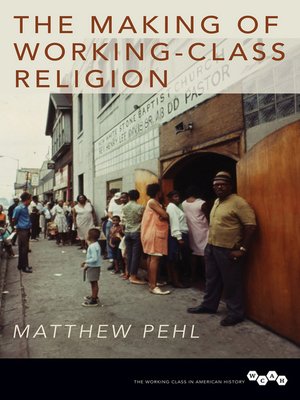
Sign up to save your library
With an OverDrive account, you can save your favorite libraries for at-a-glance information about availability. Find out more about OverDrive accounts.
Find this title in Libby, the library reading app by OverDrive.



Search for a digital library with this title
Title found at these libraries:
| Library Name | Distance |
|---|---|
| Loading... |
Pehl embarks on an integrative view of working-class faith that ranges across boundaries of class, race, denomination, and time. As he shows, workers in the 1910s and 1920s practiced beliefs characterized by emotional expressiveness, alliance with supernatural forces, and incorporation of mass culture's secular diversions into the sacred. That gave way to the more pragmatic class-conscious religion cultures of the New Deal era and, from the late Thirties on, a quilt of secular working-class cultures that coexisted in competitive, though creative, tension. Finally, Pehl shows how the ideology of race eclipsed class in the 1950s and 1960s, and in so doing replaced the class-conscious with the race-conscious in religious cultures throughout the city.
An ambitiously inclusive contribution to a burgeoning field, The Making of Working-Class Religion breaks new ground in the study of solidarity and the sacred in the American heartland.
| Cover Title Page Copyright Contents Introduction 1. The Contours of Religious Consciousness in Working-Class Detroit, 1910–1935 2. Power, Politics, and the Struggle over Working-Class Religion, 1910–1938 3. Making Worker Religion in the New Deal Era 4. Race, Politics, and Worker Religion in Wartime Detroit, 1941–1946 5. The Decline of Worker Religion, 1946–1963 6. Race and the Remaking of Religious Consciousness Epilogue Notes Index | "Pehl is to be commended for his multivalent work, and for the important contributions he makes to both The Working Class in American History series and to the study of America's religious history."—Anglican Theological Review"The value of Pehl's wonderful book is that it helps us reimagine the currents of faith that ebb and flow in American society and interact with changing political and economic circumstances. This is a book that belongs on the shelves of historians." —American Historical Review
"Pehl's work makes a number of important contributions to our thinking about religion within labor history. . . . He expertly weaves together the thoughts of religious leaders and rank-and-file workers and shows the intersections of these processes among Protestants and Catholics, and African American and white workers."—Journal of American History
|Matthew Pehl is an associate professor of history at Augustana University.







